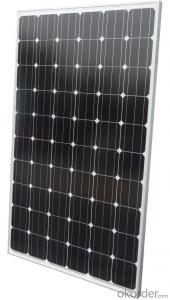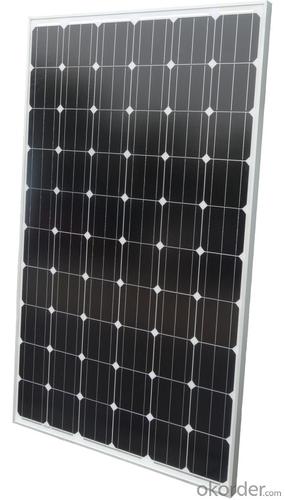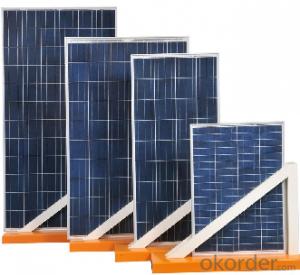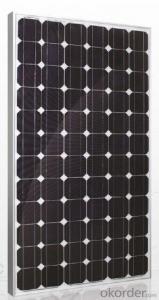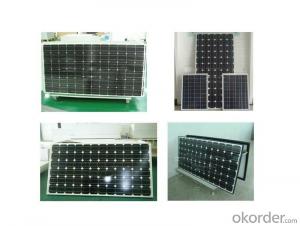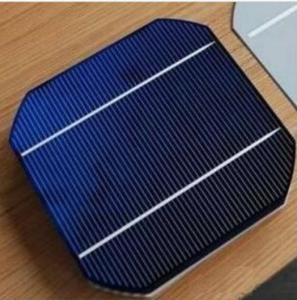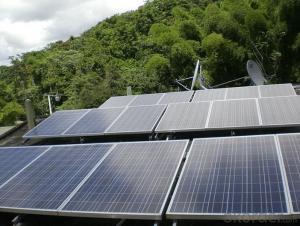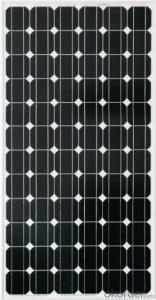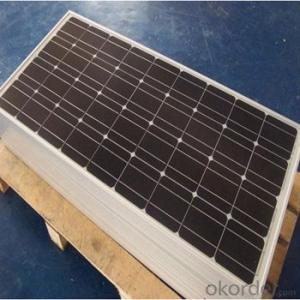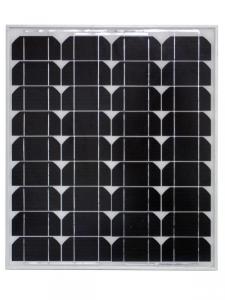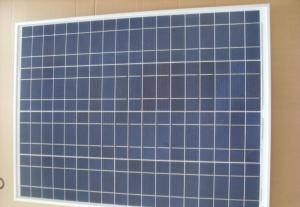Dayz Solar Panels Monocrystalline Solar Module
- Loading Port:
- China Main Port
- Payment Terms:
- TT OR LC
- Min Order Qty:
- -
- Supply Capability:
- -
OKorder Service Pledge
OKorder Financial Service
You Might Also Like
Solar Monocrystalline (210W-225W)
Introduction of Solar Monocrystalline (210W-225W)
Solar modules use light energy (photons) from the sun to generate electricity through the photovoltaic effect. The majority of modules use wafer-based crystalline silicon cells or thin-film cells based on cadmium telluride or silicon. The structural (load carrying) member of a module can either be the top layer or the back layer. Cells must also be protected from mechanical damage and moisture. Most solar modules are rigid, but semi-flexible ones are available, based on thin-film cells. These early solar modules were first used in space in 1958.
CNBM Solar photovoltaic (PV) Panel is designed for large electrical power requirements. It is the optimal choice for both on-grid and off-grid power systems. CNBM Solar panel offers high performance of power per square foot of solar array. Monocrystalline silicon(c-Si): often made using the Czochralski process. Single-crystal wafer cells tend to be expensive, and because they are cut from cylindrical ingots, do not completely cover a square solar cell module without a substantial waste of refined silicon. Hence most c-Si panels have uncovered gaps at the four corners of the cells.
Characteristics of Solar Monocrystalline (210W-225W)
I. Solar Cell : High efficiency crystalline solar cell. Even if under the weak light, the solar module can produce maximum power output.
II. Tempered glass (toughened glass): Anti-reflecting coating and high transmission rate glass increase the power output and mechanical strength of solar module.
III. EVA and TPT: Using high quality EVA and TPT to prevent destroying and water.
IV. AI frame: Without screw, corner connection. 6 holes on the frame can be installed easily.
V. Junction box: Multi function junction box with water proof.
VI. Long lifetime: ≥25 years; Less power decrease.
VII. Good performance of preventing from atrocious weather such as wind and hails.
VIII. Resisting moisture and etching effectively, not effected by geology.
IX. The certificate issued by international authority: UL, TUV, IEC, VDE, CE.
Standard Test Conditions of Solar Monocrystalline (210W-225W)
The opto-electrical specifications shown below are stabilized values being measured at Standard Test Conditions, Irradiance: 1000W/m2, Spectrum: AM1.5 at 25°C, The info below is subject to manufacturing tolerances. Where appropriate minutes of measurement are available and are used for the dimensioning of the installation.
Advantages of Solar Monocrystalline (210W-225W)
• CNBM Solar performance guarantees for 25 years
• 10 years guarantee for workmanship
• Timeliness of delivery
• Quality Products certified (TÜV, UL, CE, VDE, ISO)
CNBM International Corporation's products including Monocrystalline Solar Panel, Polycrystalline Solar Panel have received and enjoyed famous reputation in many countries and regions in the world .As a solar panel manufacturer in China, we strive to provide our customers with excellent service, superior products and unmatched value.
- Q: How do solar panels affect the overall resilience of a building?
- Solar panels can significantly enhance the overall resilience of a building. By harnessing renewable energy from the sun, solar panels provide a reliable and sustainable source of electricity, reducing the dependency on traditional power grids. This independence ensures that essential services, such as lighting, heating, and cooling, can still function during power outages. Additionally, solar panels contribute to energy savings, reducing long-term operational costs and making a building more financially resilient. Moreover, solar panels reduce carbon emissions, mitigating the impact of climate change and enhancing the building's resilience to environmental challenges.
- Q: How do solar panels impact the aesthetics of a building?
- Solar panels can impact the aesthetics of a building in both positive and negative ways. On one hand, when designed and installed properly, solar panels can enhance the overall appearance of a building by giving it a modern and eco-friendly look. Additionally, the sleek and reflective surface of solar panels can add a visually appealing element to the design. On the other hand, some people may find the presence of solar panels on a building to be visually unappealing, especially if they disrupt the architectural harmony or contrast with the surrounding environment. Ultimately, the impact of solar panels on a building's aesthetics is subjective and depends on individual preferences and the integration of the panels into the overall design.
- Q: I had an idea for new parabolic solar panels shaped like horseshoes. They can install them outside buildings facing the equator. They could angle them from the ground based on how many degrees latitude the location and rotate them according to seasonal changes. The disadvantage of photovoltaic panels is that they are not all capable of receiving direct sunlight. That is the quintessential reason I believe horseshoe solar panels are more effective than flat rectangular ones. One side could function in the morning; the middle could perform at midday; and the other could operate during the evening. That method seems more sensible than hourly positioning. I'm certain horseshoe panels could save and produce more electricity. A football stadium, shopping mall, or outlet center would be a fantastic place. What do you think?
- Well here would be the problem with a horseshoe panel... Due to its shape, you will get a seriously uneven distribution of solar charge. Since the horseshoe shape resembles a parabolic function, the majority of the electrical photovoltaic cells will be spanned over the larger rise/run, meaning the two ends of the parabolic shoe. A way to combat this is that as it approaches 0 from both sides (0 tangency) is to put a higher concentration of photovoltaic cells in comparison to the two ends on either side. An even better design I would say would not to use a flat panel or even a horseshoe, but instead, use a sphere shape. It's globe-like shape would never need to be adjusted. The side pointing towards the sun would absorb and the remaining 360 degrees of shape would absorb ambient light which can trickle in tons of ambient charge. It is an eyesore but the round shape would be the most efficient. If you think about it, nature is the best example to model. Just look at a tree. It's general tree shape is rounded so that all the leaves can pick up some sort of light throughout the day.
- Q: How often do solar panels need to be replaced or repaired roughly? Is it costly to do so?
- Maintenance Of Solar Panels
- Q: What about sources for straight forward solar powered products? Excluding toys, garden frogs and outdoorpath lights I have found few useful items for the home. What I have found are solar panels for under $00 each, inverters, rechargeable indoor lights and a few camping/RV products that are interesting. It seems to me that these could help me start to wean the family off the power company. I can't afford to go cold turkey and cover my roof with solar panels and I don't think the HOA would allow me to even if I could. Is anyone using solar on a small scale?
- Homemade okorder
- Q: Can solar panels be used in areas with high levels of hurricanes?
- Yes, solar panels can be used in areas with high levels of hurricanes. However, it is important to ensure that the solar panels are properly installed and secured to withstand the strong winds and potential debris that hurricanes can bring. Additionally, selecting hurricane-resistant solar panels and implementing proper maintenance and inspection procedures can help to mitigate potential damage and ensure their long-term functionality in these areas.
- Q: if so, would it be possible to make (or remake) an organism that could subsist off of sunlight and external heat like plants?
- Plants and algaes and cyanobacteria already exist. What exactly do you want?
- Q: Can solar panels be used for large-scale power generation?
- Yes, solar panels can definitely be used for large-scale power generation. With advancements in technology and decreasing costs, solar power has become a viable option for utility-scale projects. Large solar farms comprising thousands of panels are being built around the world to generate electricity on a massive scale. These solar installations have the potential to provide clean and sustainable energy for cities, industries, and even entire regions.
- Q: first of all, to be honest i have totally no idea on how a solar panel works.my task is to design something like a solar powered street lamp which store sun energy during day time and convert it into electrical energy then light energy so that the lamp can work during night time.any ideas on how to design the solar panel? which can store enough or more enegry in case there is no sunlight another day. and low cost as well :D
- solar panels are designed to charge 2v batteries, now depending on the power you need you can determine what kind to use there are many power ratings for the modules, for example if you want to charge two 2v batteries you can connect them in parallel, if you want to reduce the charging time you can use more than one module in parallel to increase the power.
- Q: How do solar panels withstand hail and other extreme weather conditions?
- Solar panels are designed to be durable and withstand various weather conditions, including hail and extreme weather. They are typically made with tempered glass, which is highly resistant to impacts from hail and other debris. Additionally, the solar cells are encapsulated in a protective layer of materials such as ethylene-vinyl acetate (EVA) and fluoropolymer, which provide further protection against weather elements. The structural design and mounting systems also ensure that solar panels are securely installed to withstand strong winds. Overall, the combination of robust materials and careful construction allows solar panels to withstand hail and other extreme weather conditions.
Send your message to us
Dayz Solar Panels Monocrystalline Solar Module
- Loading Port:
- China Main Port
- Payment Terms:
- TT OR LC
- Min Order Qty:
- -
- Supply Capability:
- -
OKorder Service Pledge
OKorder Financial Service
Similar products
Hot products
Hot Searches
Related keywords
